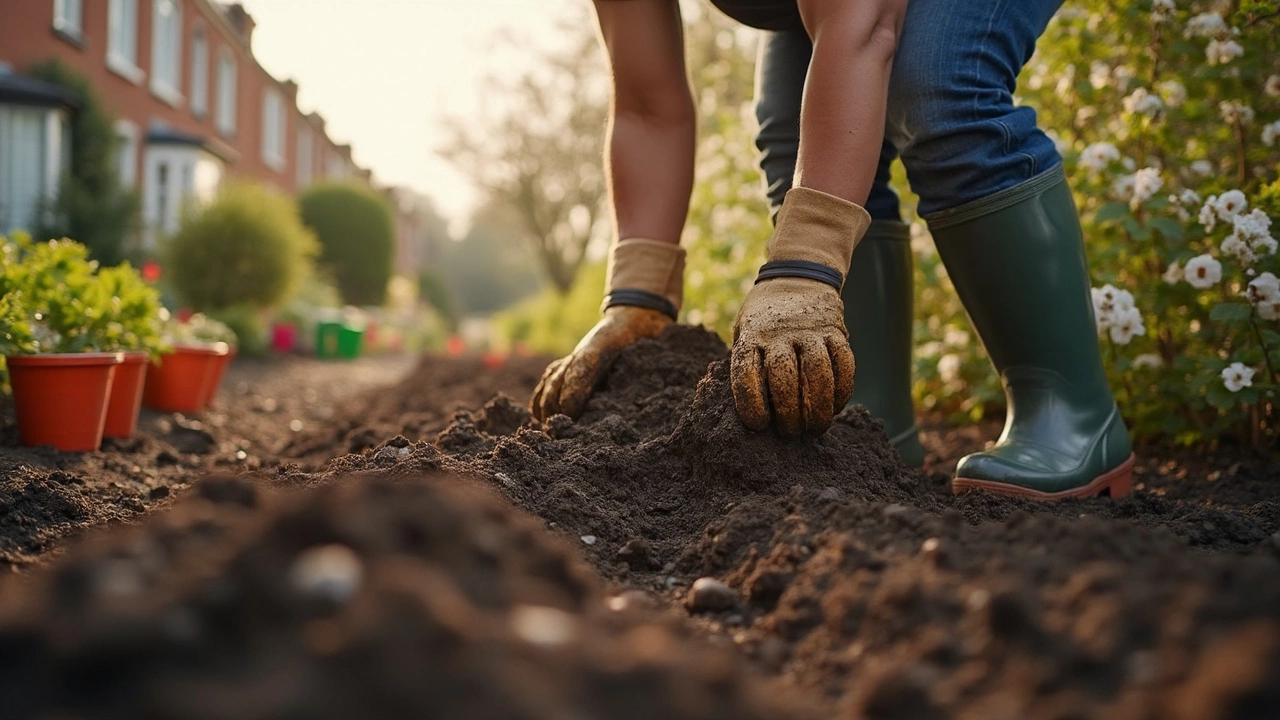Building your first flower bed sounds like a big task, but you can get it done with just a few smart steps. Skip the guesswork—most successful gardeners start by picking a spot that actually works for the plants, not just where it looks good. Look out your window: the best areas usually get at least six hours of sun, have decent drainage, and aren’t too close to tree roots that suck up all the water.
Don’t make the rookie mistake of just throwing flowers into grass. Take a few minutes to mark off your future bed with a garden hose or string, so you see the shape before digging. Rounded edges are easier to mow around, and beds a little wider (about 3 feet or more) let you squeeze in a mix of plants instead of a lonely row. Quick tip: straight lines look sharp but can feel stiff; curves give a softer, friendlier look. Trust your eye and snap a photo—sometimes it’s easier to spot what works on your phone than in person.
- Choosing the Right Spot
- Prepping the Ground and Soil
- Plant Selection and Layout Tricks
- Caring for Your New Flower Bed
Choosing the Right Spot
If you want your flower bed to actually thrive, start by scoping out what happens in your yard throughout the day. Plants can’t move, so putting them in the wrong place is setting them up to fail. Grab a cup of coffee and hang around your yard for a bit; you’ll instantly spot the sunny and shady patches as the hours pass. Most bedding flowers like marigolds, petunias, or zinnias honestly need about 6 hours of direct sun—shade-loving stuff like impatiens get weird and leggy if they get too much.
Drainage is another thing newbies often ignore. Flowers don’t love soggy feet. After a heavy rain, check if any spots stay sloppy or puddled for more than a few hours. That’s not your best bet for a bed—pick higher ground, or an area with looser soil instead. If it’s always wet, you’re asking for root rot and dead blooms.
| Light Level | Plants that Work Best |
|---|---|
| Full Sun (6+ hrs) | Sunflowers, Marigolds, Echinacea, Zinnias |
| Part Shade (3-6 hrs) | Hostas, Astilbe, Foxglove |
| Full Shade (<3 hrs) | Impatiens, Ferns, Begonias |
Avoid setting your new garden design under big tree canopies. Larger trees pull a ton of water out of the ground, can crowd out younger plants for sun, and roots can make digging a chore. If you have pets, steer clear of places they run laps. Also, keep in mind hose reach—you’ll regret a bed that needs hand-carried water every night in July.
One more tip: put your beginner gardening project somewhere you see every day, like close to the porch or by the mailbox. Most people enjoy their flowers a lot more when they notice every little change—and it’s way easier to spot weeds or plants that need a drink.
- Watch sun patterns before you pick your spot
- Check for drainage after a rain
- Avoid root-heavy or pet-traffic zones
- Plan for ease of watering and enjoying the view
Prepping the Ground and Soil
If you want your flower bed to thrive, the groundwork is where you start winning or losing. Don’t just plop plants into any old dirt. Most yards have soil that’s too hard, too sandy, or too full of clay for flowers to be happy. Test your soil first—a basic kit at the garden store and five minutes can tell you what you’re working with. Aim for soil that drains well and is full of organic stuff, not rock-hard earth.
Step one? Clear out grass and weeds. Use a flat shovel or spade to dig the area, removing sod, roots, and anything that could compete for space or food. Don’t skip this step; leftover grass will find a way back every time.
- Dig at least 6–8 inches deep. Most beginner gardening flowers need room to stretch their roots.
- Chuck in some compost, old leaves, or mulch—whatever you’ve got to beef up the organic matter. A wheelbarrow of compost per 10 square feet gives most beds a big boost.
- Break up big clumps. Use your hands, a rake, or a simple gardening fork. The goal is loose, airy soil that’s easy for roots to push through.
If you want to get super specific, here’s a cheat sheet on soil types and what flowers like:
| Soil Type | Drains Well? | Extra Tips |
|---|---|---|
| Clay | No | Add sand and compost to lighten it up |
| Sandy | Yes | Add compost to hold nutrients and moisture |
| Loam | Perfect | This is gold for a flower bed—just mix in a little compost |
Finish by smoothing the surface with a rake so it’s level and there aren’t any dips that will hold water. Let the bed sit for a day or two if you can, then you’re set for planting.

Plant Selection and Layout Tricks
Picking what to plant is a make-or-break deal for any beginner. It’s tempting to grab every pretty bloom you see at the garden center, but pause before you fill the cart. Focus on a mix of sturdy, low-fuss flowers like marigolds, zinnias, and begonia—they don’t need a lot of babying and still put on a good show. If you want perennials that pop up every year, try coreopsis, black-eyed Susans, and daylilies. They stick around and leave fewer gaps down the road.
Before you start digging, check the labels for sunlight and water needs. Don’t mix heavy sun-lovers and shade fans in the same bed. It only leads to disappointment. Here’s a pro tip: grouping plants with the same needs helps your flower bed thrive and cuts down on hassle later.
It’s not just about which plants you pick, but how you arrange them. You want taller plants in the back, medium ones in the middle, and little guys upfront, especially if your garden design backs up to a fence or wall. For beds that can be seen from all sides, plant the tall ones in the middle and work down in height outwards—think of it like arranging seats for the best view at a concert.
- Repeat a few colors or plant the same type in small groups (odd numbers look best—try 3 or 5 of a kind) to pull the look together.
- Mix different leaf shapes for texture. Broad leaves next to skinny ones always pop.
- Don’t crowd the plants. Leave them enough space so everyone can breathe and grow.
If you want instant results, some folks add a few annuals for quick color while the perennials settle in. Write down what you plant and where. By next season, you’ll be glad you did—memory tricks only go so far.
| Popular Easy Plants | Height (inches) | Sun Needs |
|---|---|---|
| Marigold | 8-30 | Full Sun |
| Coreopsis | 12-24 | Full Sun |
| Begonia | 6-18 | Partial Shade |
| Black-eyed Susan | 18-36 | Full Sun |
| Zinnia | 12-36 | Full Sun |
Getting the planting tips right saves you headaches down the line. Don’t skip this step, and your flower bed will look like you’ve done it for years.
Caring for Your New Flower Bed
Getting the plants in is just the first lap—the real trick is keeping that flower bed looking good all season. Start with water. New plants are thirsty, especially during the first few weeks. Aim to keep the soil damp but not soggy. Stick your finger in the dirt; if the top inch feels dry, it's time to water. Early mornings are best, since leaves dry off during the day and you avoid fungus problems.
Next up: mulch. A two-inch blanket of mulch keeps moisture in and weeds out. Bark chips, shredded leaves, or even pine needles all work. Mulch also makes your garden design look finished with barely any effort. Just keep the mulch a couple inches away from plant stems so they don't rot.
Weeds are sneaky. Walk your flower bed every week and yank them before they get settled in. If you fall behind, they’ll steal water, food, and sunlight from your plants. While you're at it, watch for plant problems. Crispy leaves usually mean too little water. Leaves turning yellow are often crying out for food—a sprinkle of slow-release fertilizer can help, just don’t overdo it.
Here’s the truth: most beginner gardeners water and weed but forget deadheading (removing faded blooms). It's an easy step that keeps your beginner gardening looking sharp and pushes some flowers, like zinnias and marigolds, to keep blooming through the whole summer.
- Water deeply, not just the surface.
- Mulch every year to prevent weeds and keep things tidy.
- Pull weeds fast, before they spread.
- Fertilize based on plant needs—don’t guess.
- Deadhead spent flowers to boost more blooms.
One fun fact: mulch can cut back weeds by up to 90%—seriously, it lets you spend more time chilling and less time battling crabgrass. Keep these routines up and your first flower bed will only get better year after year.
